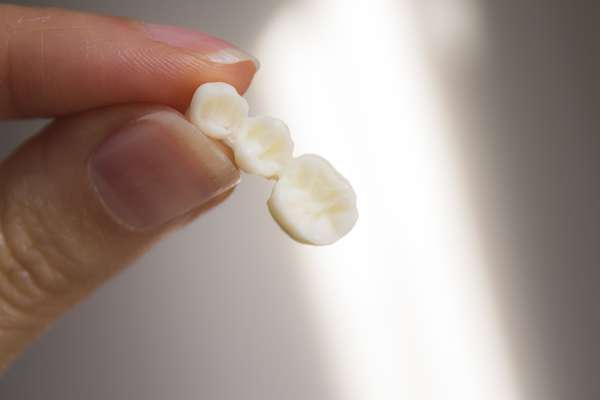 Many dental patients are self-conscious about missing teeth. Depending on the exact teeth that have been lost, this condition can also make it difficult to chew food. In many cases, a dental bridge can be used to replace lost teeth and restore a patient's smile.
Many dental patients are self-conscious about missing teeth. Depending on the exact teeth that have been lost, this condition can also make it difficult to chew food. In many cases, a dental bridge can be used to replace lost teeth and restore a patient's smile.
How do dental bridges work?
As the name suggests, a dental bridge uses an artificial tooth (called a "pontic") to bridge a gap in a patient's teeth. If pontics are not implanted into the jawbone, they need to connect to existing teeth.
Dental bridges connected to natural teeth
A traditional dental bridge connects the pontic to two dental crowns on either side of the gap. In this procedure, each tooth on either side of the gap is fitted with a dental crown, and the pontic is cemented to each crown. A simpler variant of the traditional bridge is the cantilever bridge, which connects a pontic to a single dental crown.
In some cases, a patient may prefer not to have the teeth on either side of a gap fitted with crowns. For these patients, a Maryland bridge may be a solution. A Maryland bridge also uses a pontic, but it is cemented to the natural teeth on either side of a dental gap. There is no need to fit these teeth with dental crowns, which simplifies the procedure.
Implant-supported bridges
For patients missing multiple teeth in a row, it is impossible to connect a pontic to two natural teeth. In these cases, implant-supported bridges may be advisable. For example, if a patient is missing three teeth in a row, the dental provider may place two implants and cement a pontic in the middle.
Getting implant-supported bridges tends to take longer than with other bridge types. Generally, an initial surgery places the implants, and the bridge is only placed after the implants have healed and successfully integrated with the jawbone. While the procedure takes more time, implant-supported bridges are usually considered to be the most stable and long-lasting bridge option available.
Check out what others are saying about our dental services on Yelp: Dental Bridges in Fort Lee, NJ.
Is a dental bridge or an implant a better solution?
While dental bridges can be an economical way to replace one or more missing teeth, they do have one important limitation: They usually need to be replaced after between five and 15 years. In younger patients, bridges may not be the first choice for tooth replacement. Some dental professionals may choose to go with a dental implant, which is a more permanent solution.
For patients who are unsure if they need a dental bridge or an implant, it is a good idea to speak with a dental professional. Dentists can talk through the benefits and drawbacks of each option and often will make a recommendation based on the individual patient's circumstances.
Conclusion
Missing teeth can cause problems in everyday life, but patients can consult a dental professional for guidance on their replacement. Thanks to advances in dental technology, dental bridge replacements often blend in with the rest of a patient's new smile.
Request an appointment or call Fort Lee Family Dental at 201-620-9772 for an appointment in our Fort Lee office.
Recent Posts
Dental bridges and dental crowns are wonderful, durable options to restore a smile. However, they are both employed for different reasons. By understanding the specifics of both, patients can learn which option is best for their needs when consulting with a dentist.Dental bridges are recommended after a tooth extraction, whether by trauma or professional intervention.…
A dental bridge is not a permanent restoration despite the changes that the neighboring natural teeth will go through for the treatment. However, there are different types available, each one capable of meeting your dental needs. Your dentist can present both permanent and removable options. Here are the details on the impermanence of a dental…
Missing teeth can negatively impact your smile's appearance and health. However, there are treatments out there that can help. Dental bridges are a common dental restoration that can improve oral health and enhance your smile. A dental bridge can be an effective solution if you have lost a tooth due to decay, injury, or other…


